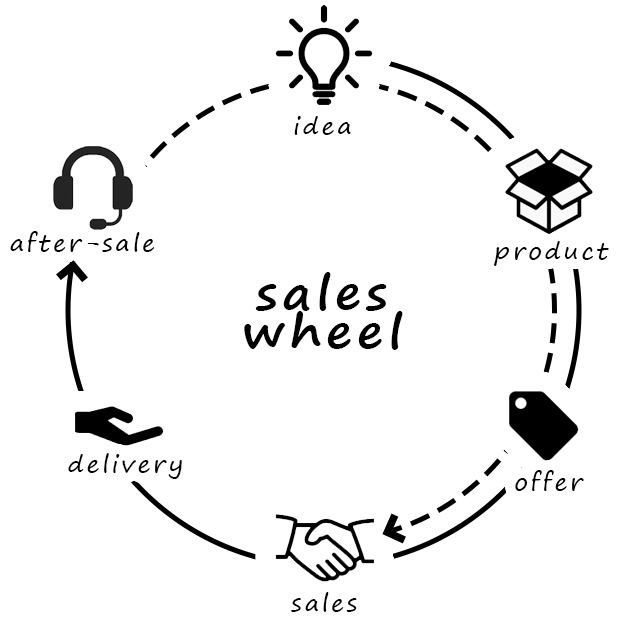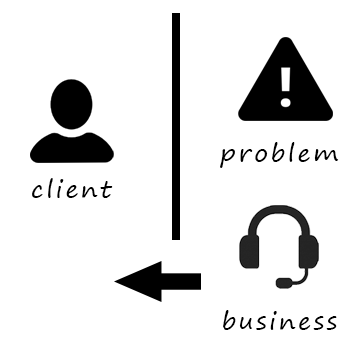As a company, the lifeblood of the business is sales.
Without sales, there is nothing: no great ideas, no fantastic products and above all, no future, no hope.
Many businesses have difficulty selling, finding prospects and turning them into customers.
To prevent the worst, we will see in this article how to avoid it by understanding the clear process with simple tips and tricks.
The Sales Wheel
The Business Wheel is representative of the process, start to finish:

That shows you the step to transform
- An Idea for a Product
- An Offer to a Sale
- Deliver the product
- Manage After-Sales
- And Repeat…
We will talk about all these steps later on the website, but for now, let’s focus on this.
You are at the last step, where you successfully delivered and want to capitalise on it:
Remarketing and Repeat sales, the best bit!
You already have the funds, and everything seems to be the best in the world.
But what could be worse than not selling?
After having spent considerable energy creating an offer with a product that everyone should want, a significant acquisition cost to finally make this sale and deliver, the worst is to come:
Your customer is not satisfied and wants a refund!
Just have a look at the return rate in Europe:

10 to 20% is the average, according to the type of products and age group.
A Cost Higher Than You Think
It is not finished; there is more to come:
Now you have spent all this effort you will find possibly more consequences:
- Bad review
- Unhappy customer
- More time to spend with the customer service
- More money to spend to return the product
This is a lot! We sometimes prefer not to sell at all!
It is why the selling process must be accurate and not short-term thinking.
The good news is that I would tell you how to improve the worse:
Avoid returns and make your customers happy to buy more from you!
There is no fancy formula or email templates, this is only years of experience.
Let’s dig in…
Understanding Why?
Of course, you need to understand why there is a problem, and why the customer finally changed his mind.
Here the most of the return/refund reasons:
- Unmet expectation
- Damaged
- Wrong item dispatched
- Found somewhere else
- Changed his mind
- Wrong product ordered
- Unknown
Once you know what the reason is you need to find a way to avoid this from happening in the future.
Is it something you can control? Is it easy to manage or expensive?
Sometimes we must accept that everything is not in our hands, and it is better to have a certain rate of return. But when we can improve and change things that will reduce the return rate, this is something to consider.
Return Reason -> Fix/Reduce/Avoid/Ignore
Communication is key
The way you communicate with the customer is significant.
I was surprised to see many salespeople doing things the wrong way.
The customer has a problem, and we do not want to be on his opposite side because we will be seen as The problem.

We want to be the Guide, that will help him to solve HIS problem. We are on his side and we will do everything we can to solve this issue, e.g.:
The carrier did not deliver correctly?
We are sorry that “the carrier” damaged your product during the delivery..
When it is not our fault, just say it, simply.
Show the best you can do to help, and the customer must believe in you, even if the resolution is not that good. If he feels that you did the best, he will understand and like you. Turn the words that help like “with you” “help you” and “for you”…
This is the time to do some zeal: there is never enough for your customer. At this stage the only thing important for the customer is himself. You must over-deliver and offer the best follow-up as is possible:
I wrote a special note on your order that we have to contact the carrier if the delivery is not done before XY and Z.
I will come back to you on Monday to be sure we are progressing
I totally understand that this is not acceptable, it is why I XY and Z to help you.
Offer Different Doors to Open
We have already talked about communication and Doors are the main topic we will use.
We do not want to go straight to the refund door. That is absolutely the last option; even if the customer asked for a refund in the first place.
The customer wants to have choices (doors to open):
Never offer him only one option, it is too frustrating.
The scenarios could be like this:
- Change his mind
- Discount
- Exchange/Return
- Upgrade
- Refund
1. Change his mind
If for any reason the customer wants to finally keep the product because you convinced him or otherwise, this is the best: no hassle, no cost.
2. Discount
In case a product has been damaged, the easiest way is to discount it. Offer first a discount and see how the customer reacts. If he doesn’t want to, ask for what discount he thinks will be fair. And you will be able to negotiate it with the manager (even if you don’t have one or you are the manager)?
The discount must be at least lower than the cost of an exchange or return.
3. Exchange or Return
The process of an exchange or return is the most complicated; you have to manage the return and deliver a new product.
A return form must be filled and signed to clearly engage the customer, as a responsibility, but also the return is made in a good manner (protection, delay..).
This scenario can be also used as an upgrade:
4. Upgrade
Sometimes the size or colour doesn’t fit or the expectation doesn’t meet the customer’s standard.
A trick I used many times when the wrong product was delivered, was to offer it with a special discount. The best is to have the product cost and the re-delivery covered by the extra amount paid by the customer.
5. Refund
You never mention a Refund in your email or chat, that must be not a visible or easy option for the customer.
This is the last thing you want to do, offer first a voucher code to reduce the cost otherwise, it’s just a pure loss.
Did You Solve the Problem of an Order Cancellation?
If you successfully solved the problem, meaning not refunded, you have to capitalise on it:
Make your customer so happy that he will drop an awesome review and buy again.
Navar 2020 study found that 76% of satisfied customers with their returns process said they would buy again, and 33% of repeat customers who had difficult return experiences will not shop again.
A voucher code can be welcome to congratulate your customer and help him to find the path.
It is never too late to ask for it. The customer will remind more of the last part of the experience:
Finish on the top of the roller coaster.
Make your Hero (Customer) Happy
Now you know how it is painful, you must do everything you can to avoid any refund.
Depending on the context, many things can work.
- Communicate clearly with the customer in the right manner
- Offer the best options first
- Be on the side of the customer
- Make the customer happy and Ask for reviews